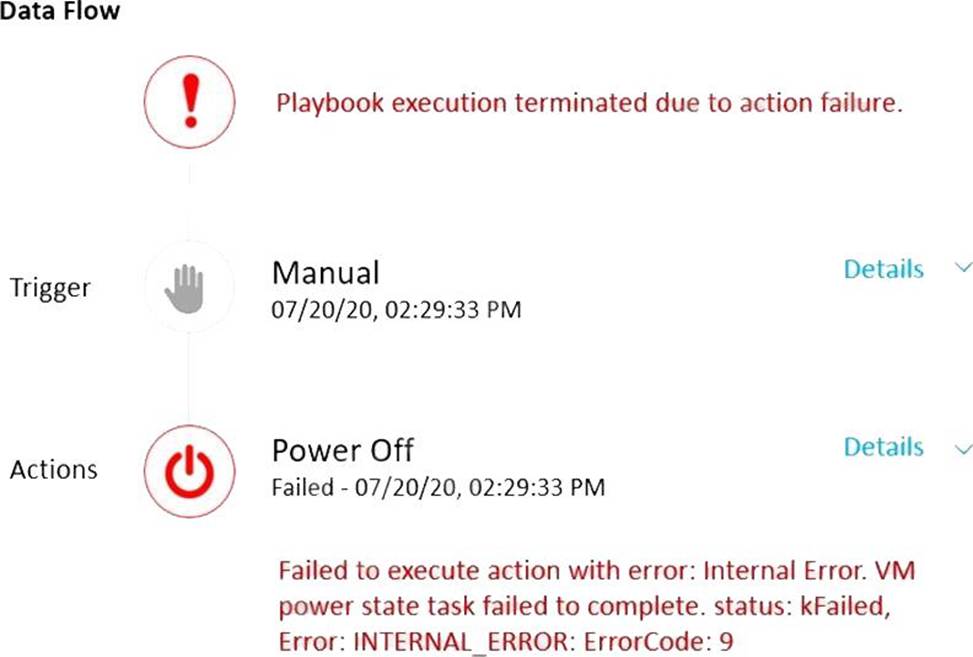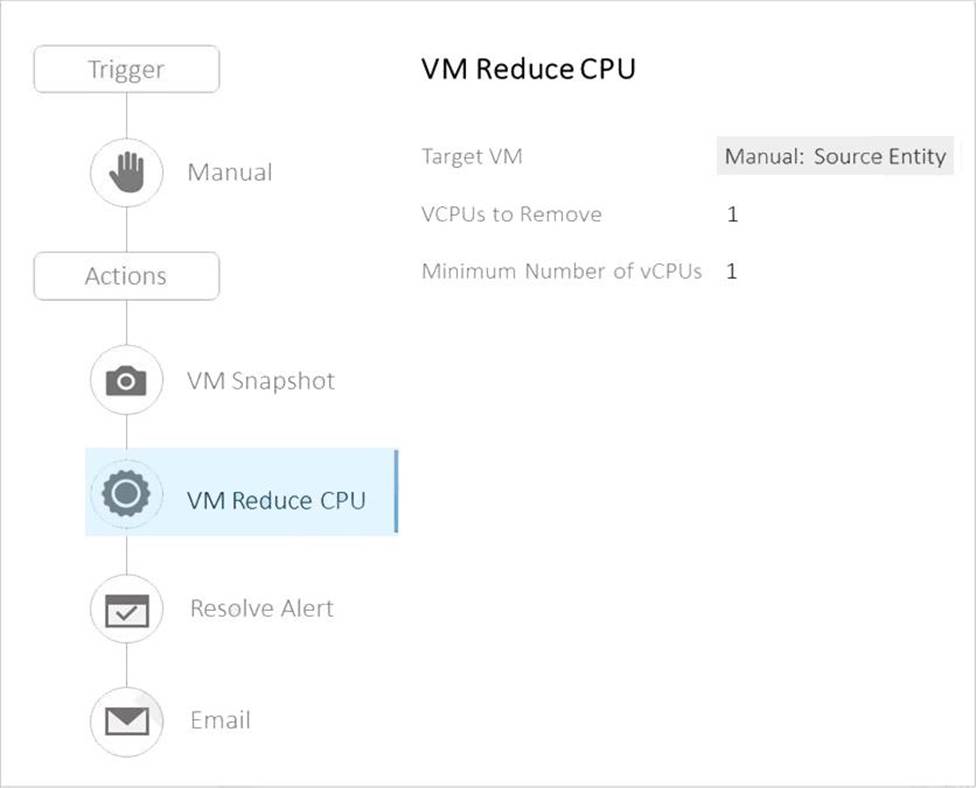Practice Free NCP-MCA Exam Online Questions
Refer to the exhibit.

A subset of Linux VMs are required to be gracefully shutdown each evening. A Playbook is created to shutdown the targeted VMs, however the error message shown in the exhibit is displayed when the Playbook is executed.
What is causing the error message?
- A . User executing the Playbook does not have Admin privileges.
- B . The VM is already powered off.
- C . The VM is missing Nutanix Guest Tools.
- D . The SSH Service is not running on the VMs.
D
Explanation:
According to the Nutanix Multicloud Automation Administration (NMCAA) course1, one of the prerequisites for using X-Play to automate tasks on VMs is to have SSH enabled and configured on the target VMs. This allows X-Play to connect to the VMs and execute commands or scripts remotely. If the SSH service is not running on the VMs, then X-Play will fail to connect and perform the actions, resulting in the error message shown in the exhibit. The other options are not likely to cause this error, as they are either unrelated to X-Play (A and B) or not required for X-Play to work ©.
Reference: Nutanix Multicloud Automation Administration (NMCAA) course
Refer to the exhibit.

An administrator created the Playbook shown in the exhibit to allow for manual reduction of vCPU count on any selected VM within their environment. During a test run of the play on one of the VMs running in development, the administrator ran into an error that the Playbook cannot be completed against the selected VM.
Here are the details of the affected VM:
VM Name: VM2
vCPU: 4
RAM: 8 GB
OS: Windows 2016
Hypervisor: AHV
What caused this Playbook to fail?
- A . This play cannot be executed against a VM on AHV.
- B . The VM needs to be powered off before vCPU can be reduced.
- C . Reduction of vCPU cannot be done on a VM with a running snapshot.
- D . The play will cause the VM to go below the minimum vCPU.
C
Explanation:
The Playbook is designed to manually reduce the vCPU count on any selected VM within the environment. However, it failed during a test run on VM2 because there was a running snapshot of the VM. According to Nutanix Multicloud Automation (NCP-MCA) principles, you cannot reduce the vCPU count on a VM that has an active snapshot1. This is because the snapshot captures the state of the VM configuration and data, and reverting to a snapshot will restore both the guest OS and the virtual hardware2. Therefore, changing the vCPU count while a snapshot is running will cause inconsistency and error.
The other options are incorrect because:
What is the prerequisite before a Single-VM Blueprint in Self-Service (formerly Calm) can be published to the Marketplace?
- A . Creating Approval policies and Endpoint
- B . Creating a Project
- C . Creating a project and Environment
- D . Creating a Endpoint
C
Explanation:
Before a Single-VM Blueprint in Self-Service (formerly Calm) can be published to the Marketplace, it is necessary to create both a project and an environment. A project defines the scope and access control for the blueprint, while the environment provides the necessary configurations and settings for the deployment, such as network, credentials, and other resources.
Reference: Nutanix Calm documentation on Project Creation.
Nutanix Calm documentation on Environment Setup.
What is one prerequisite for deploying Self-Service (formerly Calm)?
- A . At least 12 GB of memory is allocated.
- B . A unique Service IP address must be configured in the Prism web console cluster tat is running on Prism, Central.
- C . A unique Virtual IP address must be configured in the Prism web console cluster that is running on Prism Central.
- D . The mDNS server is reachable from Prism Central.
C
Explanation:
One prerequisite for deploying Self-Service (formerly Calm) is that a unique Virtual IP address (VIP) must be configured in the Prism web console cluster that is running on Prism Central. This VIP is necessary for high availability and to ensure that Self-Service can be accessed reliably.
Reference: Nutanix Calm documentation on Deployment Requirements.
Nutanix Best Practices for Configuring VIP.
What is the correct method to upgrade Calm?
- A . Calm Marketplace
- B . LCM via Prism Element
- C . LCM via Prism Central
- D . Calm Dashboard
C
Explanation:
You can upgrade Nutanix Calm or Epsilon (the orchestration engine used by Nutanix Calm) by using the Life Cycle Manager (LCM) from the Prism Central. LCM allows you to upgrade Calm or Epsilon independently or simultaneously. You can also select the version that you want to upgrade to and perform the update from the Options list. For more information, see the Nutanix Calm Upgrades section in the Nutanix Calm Admin and Operations Guide1 and the Performing Inventory and Upgrading Calm with Life Cycle Manager article2.
Reference: Nutanix Calm Admin and Operations Guide1
Performing Inventory and Upgrading Calm with Life Cycle Manager2
Reference: https://portal.nutanix.com/page/documents/details?targetId=Nutanix-Calm-Admin-Operations-Guide-v3_2_7:nuc-calm-esxi-upgrade-c.html
Which project enables a project administrator or user to view and manage VMs and applications of other users in the same project?
- A . Allow Collaboration
- B . Project Environments
- C . Quota Policy
- D . Users and Groups
A
Explanation:
The "Allow Collaboration" setting in a project enables a project administrator or user to view and manage VMs and applications of other users within the same project. This setting fosters collaboration and sharing of resources among users who are part of the same project.
Reference: Nutanix Calm documentation on Project Collaboration.
Nutanix Best Practices for Managing Projects.
What should be done to scale out an existing Calm environment?
- A . Create new prism Central Scale-Out VMS end enable Calm within the GUI,
- B . Back up the data and create three Calm VMS from the Calm VM QCOW2 image.
- C . Run cluster destroy on the VM that will be the master Calm VM.
- D . Beck up the data and create three Calm VMS from the Calm VM OVA template.
D
Explanation:
According to the Nutanix Calm documentation1, to scale out an existing Calm environment, the administrator needs to back up the data and create three Calm VMs from the Calm VM OVA template. The administrator then needs to configure the Calm VMs as a cluster and restore the data from the backup. The other options are incorrect because they either do not use the correct image format, do not create a cluster of Calm VMs, or destroy the existing Calm VM.
Reference: 1 Nutanix Calm User Guide: Scaling Out the Calm Cluster2
Which graphic interface allows components and their dependencies within an environment to be visualized and configured?
- A . Postman
- B . API Explorer
- C . Buleprint Editor
- D . Visual Studio Code
C
Explanation:
The Blueprint Editor in Nutanix Calm is the graphical interface that allows users to visualize and configure components and their dependencies within an environment. This tool provides a visual representation of application blueprints, enabling users to design, configure, and manage application deployments with ease.
Reference: Nutanix Calm documentation on Blueprint Editor.
Nutanix Best Practices for Designing Blueprints.
The development leadership has submitted a request to run a resource-intensive script after hours on separate test environments for testing application load. The current environments are setup as separate projects within Self-Service (formerly Calm).
Requirements:
* The script needs to run on each test environment.
* The script needs to run at separate times for each test environment.
* The development team needs the ability to modify the script as needed.
How would the administrator accomplish the task?
- A . Publish Runbook
- B . Publish Playbook
- C . Blueprint
- D . Playbook
A
Explanation:
To run a resource-intensive script on separate test environments at different times, the administrator should publish a Runbook. Runbooks allow for the automation of tasks across multiple environments and can be scheduled to run at specific times. Additionally, they can be modified by the development team as needed to adapt to changes in the script.
Reference: Nutanix Calm documentation on Runbook Publishing.
Nutanix Best Practices for Automation and Scheduling.
What minimum requirement is necessary to enable Self-Service (formerly Calm) policies for scheduling and approval tasks?
- A . Calm VM
- B . Policy Engine VM
- C . Service Now Plugin
- D . NGT Plugin
B
Explanation:
To enable Self-Service (formerly Calm) policies for scheduling and approval tasks, the minimum requirement is the Policy Engine VM. The Policy Engine VM is responsible for managing and enforcing policies, including scheduling and approval processes within Nutanix Calm.
Reference: Nutanix documentation on Policy Engine.
Nutanix Best Practices for Scheduling and Approval.
